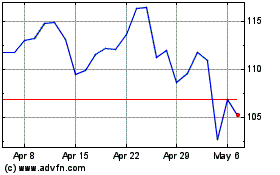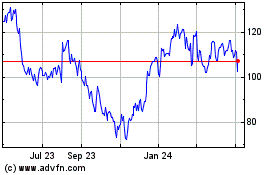iRhythm Technologies, Inc. (NASDAQ:IRTC), a leading cardiovascular
diagnostics and digital healthcare solutions company focused on
creating trusted solutions that detect, predict, and prevent
disease, today announced the results of four clinical studies
presented at the American Heart Association’s (AHA) 2022 Scientific
Sessions in Chicago, IL. The studies demonstrate health economic
and clinical value of the Zio® AT and XT product lines across a
range of diseases and clinical settings.
“The presented studies have important clinical implications,”
said Dr. Mintu Turakhia, iRhythm’s chief medical officer and chief
scientific officer. “First, screening for atrial fibrillation,
based on the mSToPS trial, is cost-effective and can provide high
value. Next, extended ambulatory ECG monitoring from our products,
compared to shorter monitoring, more accurately estimates the
burden of a common type of ventricular arrhythmia, which is
clinically consequential to patients and important to get right. We
also found that atrial fibrillation was an unexpected and important
finding in patients who receive monitoring for loss of
consciousness, which we already know benefits from Zio’s 14-days of
ambulatory ECG monitoring compared to other diagnostics. Finally,
we showed the potential for partnered healthcare system research
with EHR integration, in this case for tailored care pathways for
diverse populations.”
The mSToPS health economic study, titled “Cost-Effectiveness of
AF Screening with Two-Week Patch Monitors: The mHealth Screening to
Prevent Strokes Study,” evaluated the cost-effectiveness of
screening for atrial fibrillation (AFib) with Zio XT. The analysis
found that systematic screening for AFib in an at-risk population
with the iRhythm Zio XT patch provided high value from a health
economic perspective. Over three years, individuals prescribed Zio
XT were more likely than unmonitored individuals to have outpatient
visits — including to cardiologists — but less likely to
require emergency department visits or hospitalization. The study
demonstrated an incremental cost-effectiveness ratio (ICER) of
$17,000 per quality-adjusted life year gained — substantially
lower than accepted willingness-to-pay thresholds in the U.S. and
other healthcare systems — and the authors conclude that
screening for AFib using Zio XT provided high value.
The ventricular arrhythmia study, titled “Assessing the Optimal
Duration of ECG Monitoring Required to Accurately Establish
Premature Ventricular Contraction (PVC) Burden in a Large National
Database,” was a >10-year study between 2011 and 2022 that
analyzed PVC burden in 25,793 patients. The study sought to
determine if extended ambulatory ECG monitoring increased accuracy
for estimating burden of PVCs, which require accurate assessments
for actionability. The data showed that a 48-hour estimation of
PVCs misclassified PVC burden compared to 14-days of ambulatory ECG
monitoring. At least seven days of continuous ambulatory ECG
monitoring, which is performed by the Zio AT and XT product lines,
was necessary to achieve >95% accuracy in burden categorization.
The findings are important, as misclassification could impact
clinical decision-making.
The study titled “Near-Real Time Extended Ambulatory ECG
Monitoring in Patients With Syncope Unveils a Spectrum of
Arrhythmias and High Incidence of Atrial Fibrillation” utilized
iRhythm’s proprietary database containing arrhythmia findings of
patients prescribed Zio AT mobile cardiac telemetry for the
diagnosis of syncope, or loss of consciousness possibly from heart
rhythm disorders. The study of over ten thousand patients found not
only a high diagnostic yield (79%) with Zio AT, but an unexpectedly
high burden of supraventricular arrhythmias (69%) and AFib (9.5%)
that are generally not thought to be associated with syncope. Most
patients with AFib met criteria for an MD notification,
highlighting the value of iRhythm’s mobile cardiac telemetry. A
subgroup of syncope-indicated patients had an unexpectedly high
AFib burden — potentially requiring a different treatment
pathway.
The electronic health record (EHR) integration study, titled
“Ascension Health System Experience with Extended Ambulatory
Electrocardiographic Monitoring: Implementation of a Novel
Integrated Approach to Better Characterize Disparities in
Healthcare,” sought to determine the relationship of age, gender,
and race for AFib detection in one of the largest private
healthcare systems in the U.S. In 6,293 Ascension patients linked
to Zio XT data, the study found risk of detected AFib was highest
in older, white, and male patients; female, diverse patients below
age ≤ 65 had the lower risk of detected AFib. The study
demonstrated that EHR-linkage is not only feasible but an important
step to generate tailored care pathways within a healthcare
system.
To learn more about iRhythm, please visit the website.
About the “Cost-Effectiveness of AF Screening with
Two-Week Patch Monitors: The mHealth Screening to Prevent Strokes
Study”Authors: Matthew R. Reynolds, MD; Amy B. Stein, PhD;
Evangelos Hytopoulos, PhD; Xiaowu Sun, PhD; Steven R. Steinhubl,
MD; David J. Cohen, MD
The authors conducted a health economic analysis of AFib
screening with Zio patch monitors using patient-level data from the
mSToPS study. Clinical outcomes and costs from the payer
perspective were obtained from enrollment through three years using
Aetna claims data. Study group participants (mean age 74 years, 41%
female, median CHA2DS2-VASC score 3) wore an average of 1.7
two-week patch monitors at an average cost of $601/person. Over
three years, individuals prescribed Zio patch monitors were more
likely than unmonitored individuals to have outpatient visits,
including to cardiology, but less likely to require emergency
department visits or hospitalization. Pharmacy costs over three
years were similar between groups. Total adjusted three-year costs,
including patch monitors, were slightly higher (difference $1,170,
95% CI -1,315 to 3,657) in the monitoring group. In patient-level
projections, the monitoring group had slightly better total and
quality-adjusted survival (11.91 vs. 11.82 life years, 9.38 vs.
9.30 QALYs) and slightly higher lifetime costs, resulting in an
incremental cost-effectiveness ratio of $16,978/QALY gained. The
investigators conclude that based on lifetime projections derived
from the mSToPS study, AFib screening using two-week Zio XT patch
monitoring provided high value from a health economic
perspective.
About the “Assessing the Optimal Duration of ECG
Monitoring Required to Accurately Establish Premature Ventricular
Contraction (PVC) Burden in a Large National Database”
studyAuthors: Andrew K. Krumerman, MD; Luigi DiBiase, MD;
Jay Chudow, MD; Ardit Kacorri, MD; Alan Wilk, BS; Lori Crosson,
PhD; Kevin J Ferrick, MD
This retrospective multicenter analysis included patients
undergoing ambulatory ECG monitoring with iRhythm’s Zio patch in
the U.S. between June 2011 and April 2022 for any indication and
overall PVC burden ≥5%. The mean absolute error (MAE) in PVC burden
was calculated after 24 hours, 48 hours, and seven days. PVC
density was more frequent in men than women and in patients age
≥ 65. The MAE calculated at 24 hours, 48 hours, and seven days
were 2.96%, 2.56%, 1.34%, respectively, confirming the previously
reported decrease in measurement variability with increased patch
monitoring duration. The accuracy in categorization of PVC burden
level increased from 89.2% at 24 hours to 95.1% at seven days. The
findings underscore the importance of extended patch monitoring for
accurate PVC burden assessment, which has important treatment
implications.
About the “Near-Real Time Extended Ambulatory ECG
Monitoring in Patients With Syncope Unveils a Spectrum of
Arrhythmias and High Incidence of Atrial Fibrillation”
studyAuthors: Bobbi Lynn Hoppe, MD; Matthew R. Reynolds,
MD; Mike Hsu, PhD; Alan Wilk, BS; Lori Crosson, PhD; Marie-Noelle
Langan, MD
Data were retrospectively analyzed from 10,643 patients from
U.S. institutions with a syncope indication for monitoring.
Patients with recordings between July 2017 to December 2021 were
analyzed. Arrhythmias were defined as: AFib, ≥30 seconds at any
heart rate; SVT, ≥90 bpm for ≥4 S beats; Pause, ≥3 second; AV
Block, any third or second degree AV Block (Mobitz I or II); VT,
≥100 bpm for ≥4 V beats or PVT, TdP, VF. Detected arrhythmias were
characterized by duration, episode counts, rates, and/or burden
(where applicable). Of the 10,643 patients studied (49% female,
mean age 65.4 years, mean wear 11.9 ± 3.6 days), 8,442 (79%) had at
least one arrhythmia detected, with 3,107 (29%) having two or more
arrhythmia types. The most common arrhythmias detected in this
patient population were SVT (69%; 7,365), VT (26%; 2,716), and AFib
(9.5%; 1,015). AV blocks (3.6%; 382) and pauses (6.2%; 662) were
not uncommon.
About the “Ascension Health System Experience with
Extended Ambulatory Electrocardiographic Monitoring: Implementation
of a Novel Integrated Approach to Better Characterize Disparities
in Healthcare” studyAuthors: Robert A. Pickett, MD;
Jeffrey T. Ellis, PhD; Evangelos Hytopoulos, PhD; Lori Crosson,
PhD; Mohammed N. Khan, MD; Kristopher M. Heinzman, MD
This retrospective cohort study included patients treated at 34
Ascension centers in six states between January 2020 and April
2022. Patient EHR data were linked to proprietary device-specific
rhythm reports for analyses. Among 6,293 patients in whom EHR data
were matched to Zio XT findings, the median (IQR) age was 63 (47,
73) years, 3,816 (60.6%) were female, and 1,038 (16.5%) were
diverse. Median device wear time was 7.2 (5.0, 13.9) days. AFib was
detected in 749 (11.9%) patients, including 326 (5.2%) with 100%
AFib. Median AFib burden was 37.0% (3.4%, 100%). Older white males
had the highest risk of AFib events, whereas younger diverse
females had the lowest risk. Diverse subgroups demonstrated greater
freedom from AFib compared to white populations. The study
demonstrates the potential of EHR linkage with device-specific
outcomes to develop tailored care pathways.
About iRhythm Technologies, Inc.iRhythm is a
leading cardiovascular diagnostics and digital healthcare company
that creates trusted solutions that detect, predict, and prevent
disease. Combining wearable biosensors and cloud-based data
analytics with powerful proprietary algorithms, iRhythm distills
data from millions of heartbeats into clinically actionable
information. Through a relentless focus on patient care, iRhythm’s
vision is to deliver better data, better insights, and better
health for all.
Investor Relations Contact:Stephanie
Zhadkevich(919) 452-5430stephanie.zhadkevich@irhythmtech.com
iRhythm Media Contact:Morgan Mathis(310)
528-6306irhythm@highwirepr.com
iRhythm Technologies (NASDAQ:IRTC)
Historical Stock Chart
From Aug 2024 to Sep 2024

iRhythm Technologies (NASDAQ:IRTC)
Historical Stock Chart
From Sep 2023 to Sep 2024
